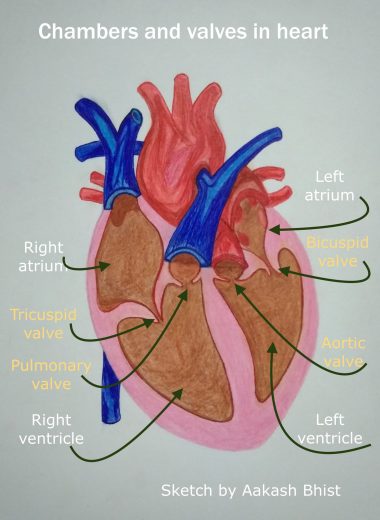Outdoor Leadership & Wilderness Medicine
Four chambers of our heart
Updated on 26 July 2020
Few of us are aware of different chambers in our heart & how they function. The heart is a strong muscle that is responsible for circulating blood in the body. It’s a muscle that works throughout the lifespan. A normal heart rate can be somewhere between 60-100 beats per minute.
The heart has 4 chambers
- – Right atrium
- – Right ventricle
- – Left atrium
- – Left ventricle

After filtration the pulmonary veins carry oxygenated blood back to the left atrium. Then from there it drops into the left ventricle. The left ventricle is the largest chamber of all four. From here the oxygenated blood is circulated to the entire body.
The heart is a sophisticated muscle where all four chambers work in synchronisation. A gap of microseconds allows the chambers to be filled with blood for pumping again.
You might be thinking, if the blood circulation happens constantly, then what prevents the chambers from being overfilled?
Four valves that ere present in the heart help prevent the overfilling of chambers. These valves are located in different parts of the heart. Valves helps connect chamber to chamber & chamber to blood vessels. Blood volume & pressure within these chambers and blood vessels forces these valves to open, helping the blood move. These valves are:
- – Tricuspid valve – Separating and regulating blood flow between right atrium & right ventricle
- – Pulmonary valve – Separating and regulating blood flow between right ventricle & pulmonary artery
- – Mitral (bicuspid) valve – Separating and regulating blood flow between left atrium and left ventricle
- – Aortic valve – Separating and regulating blood flow between left ventricle and aorta.
- Author –
- Amit Arora, Outdoor Leadership & Wilderness Medicine Educator.
- Reach out at outdooreducation.in@gmail.com to inquire about Wilderness Medicine and Outdoor Leadership training at your organisation.
- Connect with us on social platforms.
[HDquiz quiz = "14"]
“This article is intended to give a general overview of the topic. We do our due diligence to research up to date and accurate information, however the content on this site should never be used as a substitute for personal professional training or direct medical advice from your doctor. Outdooreducation.in assumes no responsibility or liability for the use of information on our website.